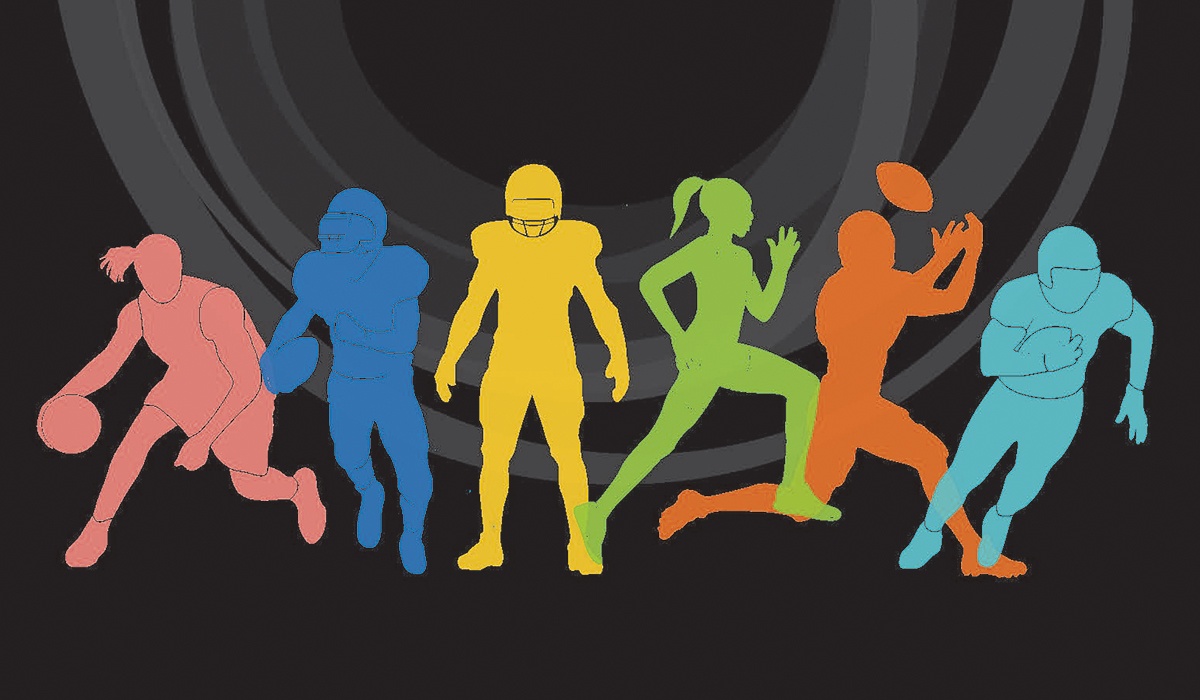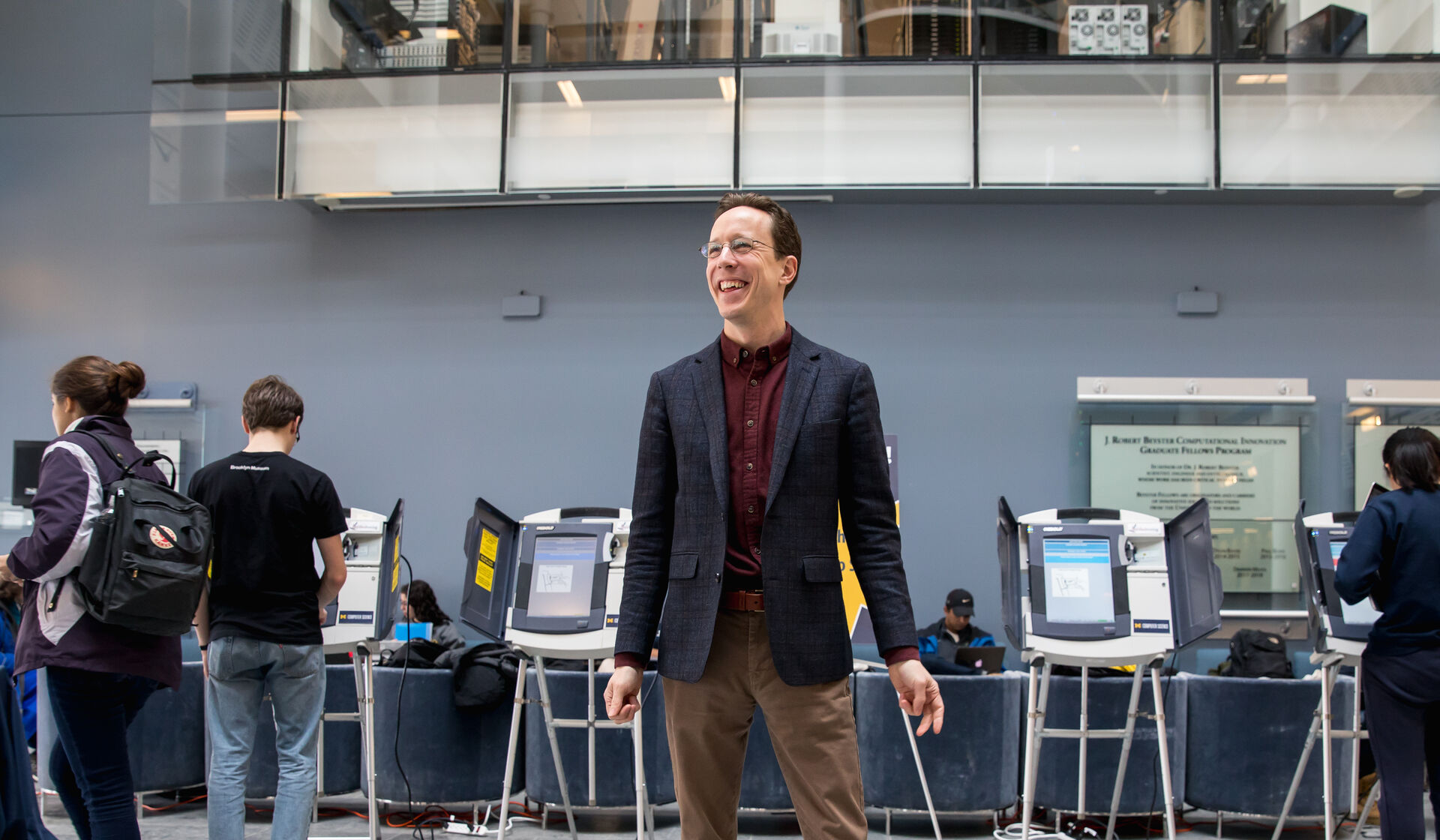 This past winter, the Alumni Association, Football Alumni of Michigan (FAM), and U-M Black Alumni gathered a group of former University athletes for the virtual, two-part event “The Intersection of the Black Student and Student-Athlete Experience.” Included in the 2021 Rev. Dr. Martin Luther King Jr. Symposium, both discussions were moderated by Eric Mayes, ’98, MS’00, co-captain of the 1997 national championship Wolverine football team and now the executive director of an equity-focused student training center at the University of Arkansas. Jason Cummings, ’99, programming chair of FAM and a former championship teammate of Mayes, helped facilitate the discussions, which included questions from students. Mayes asked the alumni — whose years at U-M span nearly five decades — to share how they found community once on campus and addressed issues of inclusion and activism. The following has been edited for length and clarity.
This past winter, the Alumni Association, Football Alumni of Michigan (FAM), and U-M Black Alumni gathered a group of former University athletes for the virtual, two-part event “The Intersection of the Black Student and Student-Athlete Experience.” Included in the 2021 Rev. Dr. Martin Luther King Jr. Symposium, both discussions were moderated by Eric Mayes, ’98, MS’00, co-captain of the 1997 national championship Wolverine football team and now the executive director of an equity-focused student training center at the University of Arkansas. Jason Cummings, ’99, programming chair of FAM and a former championship teammate of Mayes, helped facilitate the discussions, which included questions from students. Mayes asked the alumni — whose years at U-M span nearly five decades — to share how they found community once on campus and addressed issues of inclusion and activism. The following has been edited for length and clarity.
THE PATH TO U-M AND COMMUNITY
THOMAS GOSS, ’68, played football at U-M from 1965 to 1968. He worked for many corporations before becoming the first Black athletic director at U-M in 1997, a position he held until 2000. He currently runs Goss LLC, a Detroit insurance agency.
When I graduated from high school, the University of Tennessee wanted me to be the first Black athlete. My family had helped integrate the school system in Knoxville, Tennessee, where I grew up, and we did not want to go through that again. My father had always followed football at U-M and so he pushed me toward Ann Arbor. When I arrived, there were probably only 200 Black students on campus, graduate and undergraduate, and we all knew each other. There were not a lot of Black professors either. So, we reached out to find each other. The community was anybody you saw that day who was Black. You would speak to them, find out where they lived, and try to make sure they were included in your circle because there weren’t too many of us.
There were three Black football players on the team my year. Ron Johnson, ’69, who became the first Black football captain at U-M, was in my class. A year later, another 100 Black students arrived on campus. My wife, Carol, was one of them. They came through U-M’s Opportunity Award Program, established to attract more Black students from Detroit high schools. Carol was in one of the two Black sororities, and I was in one of the two Black fraternities. That is how we met.
THOMAS SEABRON JR., ’79, played football at U-M from 1975 to 1978 and in the NFL for the San Francisco 49ers and the St. Louis Cardinals. He currently works as a financial adviser for Morgan Stanley in Detroit.
The legacy of African American players on U-M’s football team went all the way back to 1890. Many other schools I was considering in the South had not even admitted a Black player. Bo Schembechler was a great recruiter and I wanted to be at Michigan. When I hit this college campus I was scared. I had been taken out of an urban environment, in my case Detroit, and thrown into an upper-middle-class, white environment, where I was supposed to assimilate. We had great coaches and academic advisers to support us, but I was still scared to death for my first two years until I learned the antidote to fear is knowledge. I learned what I was capable of and made my best friends to this day at U-M.
“The community was anybody you saw that day who was Black. You would speak to them, find out where they lived, and try to make sure they were included in your circle because there weren’t too many of us.”
—Thomas Goss
ROD PAYNE, ’01, played football at U-M from 1992 to 1996 and in the NFL for the Cincinnati Bengals before winning the Super Bowl in 2000 with the Baltimore Ravens. He currently runs Payne Athletic Consulting in Boca Raton, Florida.
My ninth-grade English teacher in Miami was the mother of Steve Everitt, x’93, a U-M football player. She showed me pictures of him. It was the first time I ever saw the winged helmet. Arriving at U-M, from the South, I literally had culture shock and no winter coat. Miami is a real melting pot. I went to high school with Dominicans, Cubans, Nicaraguans, and sandwiched in between all of them was the Jewish American and African American crowd. At Michigan, it was sort of the reverse situation. I remember studying with a group of Caucasian kids and catching some flak from some kids from Detroit.
On weekends, there were always a dozen or so Black parties on campus. You had to make a conscious decision of whether you were going to hang out with the Black or white population. One night, I decided to go out and see where all these white kids were going. I met up with some guys in my hall, and we started to walk around campus. I realized all these people were just walking around and meeting each other. That started the ball rolling for me to get out more. But as Black student-athletes, we had a bit of an open door. My experience would have been much different as just a regular Black student.
DORIS SIMMONS, ’04, competed on the track team at U-M between 2000 and 2004. She is currently dean of students at Eagle College Preparatory School in Mesa, Arizona.
When I was 11, my father was murdered. That adversity made me want something different for my life. I didn’t want to live off other people’s food stamps. When I talked to my guidance counselor about going to a big college, she told me a better fit would be a community college. Proving her wrong is what motivated me to get into U-M. I was pretty smart and graduated at the top of my class. But it was a really small school in Cassopolis, Michigan.
I started at U-M in the Summer Bridge Scholars Program, set up to help students transition to the University by giving us access to teachers in a much smaller community than we would find entering in the fall. It absolutely did what it was supposed to do, and I met great people. But I faced some big challenges on the field.
I had broken all these track records at my small high school. Now, I was surrounded by all these phenomenal athletes. The upperclassmen treated me like I didn’t belong. Because running was epic for me, I ran away. I enlisted in the Marine Corps and was deployed. When I returned a year later, the coaches and my teammates rallied around me and I got my eligibility back. They became like family. I am grateful now to be in a position to intentionally look for kids that were like me and need someone who believes in them.
ASHLEY JONES, ’10, played basketball at U-M from 2005 to 2010 before playing abroad professionally for three years. She is currently working as an engineer at Mitsubishi Electric in Detroit.
Two major factors swayed me to go to U-M: the engineering school and the location. I grew up in Detroit and wanted to see my younger siblings grow up and have them watch me play. I did U-M’s Bridge program, too. I was a bit cocky academically when I arrived at U-M. My first exam humbled me pretty quickly. I think that we have to improve on the Detroit Public Schools system to prepare students better for college. I’m very competitive, so once I got that initial exam, I made sure to do everything I needed to do to be successful moving forward. Bridge gave me the tools to do that.
I found a community beyond basketball by becoming a member of the National Society of Black Engineers (NSBE). I went from 6 a.m. to 9 p.m., Monday through Friday, to classes and practice but always attended the Friday night NSBE meetings. It was my outlet and my opportunity to reach out to people who looked like me. It was a way of doing something apart from my sport and classes.
JEHU CHESSON, ’16, MM’17, played football at U-M from 2012 to 2016 and in the NFL for the Kansas City Chiefs. He is now a free agent.
My high school tutor told me I could be a big fish in a big pond if I went to U-M. But he also said that the expectation is large on the football field and in the classroom. I felt like I had that within myself and wanted to make a name for myself and my family, who came here from Liberia. When I came to visit Michigan, I looked around and asked myself, “Do the coaches seem to care about the students? Do the professors care and, more importantly, will my teammates provide me with the kind of support I get at home?” My roommate during my official visit was Amara Darboh, ’16, a receiver from Sierra Leone. When he committed to Michigan, I committed. Both of us being from West Africa was a key component. I felt Michigan had the open-mindedness to accept my culture and heritage.
I do feel there is a preconceived notion of what to expect from a student-athlete. To counter that, I would try to get to class on time and never act like I was the most important person in the room. A lot of students would treat you that way. But then other students don’t care at all about football. The professors just want to know their class comes before your football activity, so you have to be very flexible, work with them, and just be upfront.
“When you take an athlete and you limit them to just what you see when they’re out there on the field or the court, that’s very narrow-minded.”
—Doris Simmons
NAVIGATING ACTIVISM AS AN ATHLETE
ROD PAYNE
I think U-M has gone a long way in producing athletes that are in tune with issues like Black Lives Matter. When I was a student-athlete, a lot of these issues were not at the forefront. Today, if five student-athletes want to get up and start a movement, some reporter is going to write about it. One thing most people don’t realize is just how much of our world has to be committed to athletics. Most students go home after class; we go to practice for 20 hours a week. But I think even just signing autographs and shaking hands and talking to people can break down a lot of barriers. As a Black student-athlete, you have the unique perspective of people warming to you because they or their kids emulate you.
JEHU CHESSON
I found myself in a lot of different positions where there were topics that I was passionate about and I wanted to speak about, but I had to educate myself first. Otherwise, you have those people who say, “Just shut up and play.” There are always those players who have thousands of followers on a social media platform but have no concrete, thoughtful comments to add to the conversation.
ASHLEY JONES
When I was at U-M, Barack Obama was elected president. There was more of a sense of hope, a sense of healing from some of the root wounds from our past. I think we should allow student-athletes to speak up. I’m a season ticket holder for the women’s basketball team. What I’m most impressed with is our top player, Naz Hillmon. As a woman, she is also the biggest advocate for racial issues. For a player of that caliber to use her platform to speak up for communities that might not have a voice is powerful.
DORIS SIMMONS
I think everyone has to find something you’re passionate about. If you are only allowed one platform — sports — that is very shortsighted. As a mom, who is also an educator and an athlete, I am invested in each one of those things. And I am an advocate for the country I fought for. When you take an athlete and you limit them to just what you see when they’re out there on the field or the court, that’s very narrow-minded.
THOMAS GOSS
When I was an athlete at U-M, Martin Luther King Jr. was killed. It was spring practice, and we were not supposed to miss it. But you can imagine the impact his death had on Ron Johnson and me. We told the coach, Bump Elliott, we were not going to practice. He canceled practice and made everyone go and pay attention to what had just happened. It was not Black Lives Matter, but it was, in our view, the beginning of all of that. I think athletes should be encouraged to take positions. Because at the end of the day they will become better thinkers. When I became athletic director at U-M, I felt the need to surround myself with more African Americans in that department that I could trust and count on. I felt I had a responsibility, not only for the University, but a responsibility to do that for Black people, in general.
The events on Jan. 27 and Feb. 18 are part of the Alumni Association’s Diversity Dialogue Series, which examines issues of diversity, equity, inclusion, and justice. To learn more, visit alumni.umich.edu/about/diversity.
Jennifer Conlin, ’83, is the deputy editor of Michigan Alumnus.





